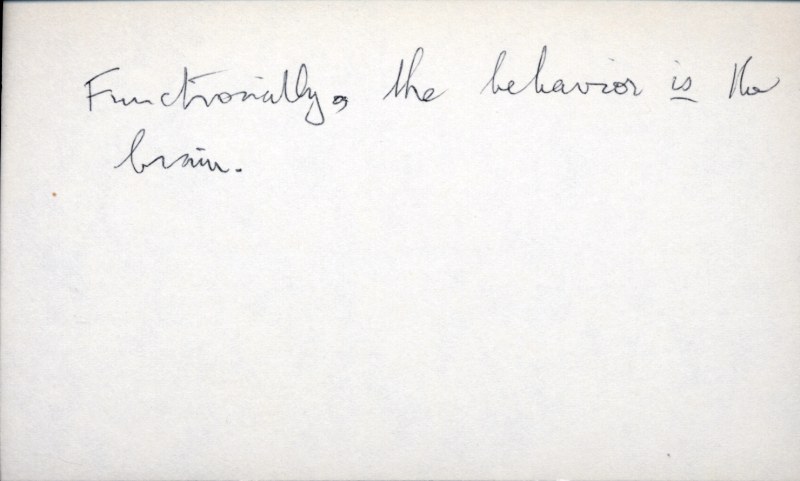Steps Towards a (Media) Ecology: Difference between revisions
No edit summary |
No edit summary |
||
| Line 4: | Line 4: | ||
W. Ross Ashby – ''Design for a Brain'' | W. Ross Ashby – ''Design for a Brain'' | ||
''"We take as basic the assumptions that the organism is mechanistic in nature, that it is composed of parts, that the behaviour of the whole is the outcome of the compounded actions of the parts, that organisms change their behaviour by learning, and that they change it so that the later behaviour is better adapted to their environment than the earlier. Our problem is, first, to identify the natnre oe the change which shows as learning, and secondly, to find why such changes should tend to cause better adaptation for the whole organism."'' <ref>Ross Ashby, ''Design for a Brain'', John Wiley and Sons Publishing, 1952p. 12</ref> | |||
W. Ross Ashby – ''Design for a Brain'' | |||
[[file:homeostat.JPG|thumb|''Homeostat, four units'']] | [[file:homeostat.JPG|thumb|''Homeostat, four units'']] | ||
| Line 15: | Line 18: | ||
What puzzled those attending Ashby's presentation of this "organism box" at the 1952 Macy conference <ref> "organism box" was coined by Gerard at the 1952 Macy conference. Others in the discussion included McCulloch, Pitts, Bateson, Bigalow and Wiener ''Cybernetics, The Macy Conferences'' p 86</ref>, was the claim that Ashby made for a broad field of evolutionary development. This led Julian Bigalow to remark: :"It may be a beautiful replica of something, but heaven only knows what." <ref>''Cybernetics Macy Conferences'' p.96</ref> | What puzzled those attending Ashby's presentation of this "organism box" at the 1952 Macy conference <ref> "organism box" was coined by Gerard at the 1952 Macy conference. Others in the discussion included McCulloch, Pitts, Bateson, Bigalow and Wiener ''Cybernetics, The Macy Conferences'' p 86</ref>, was the claim that Ashby made for a broad field of evolutionary development. This led Julian Bigalow to remark: :"It may be a beautiful replica of something, but heaven only knows what." <ref>''Cybernetics Macy Conferences'' p.96</ref> | ||
Whilst some saw the generality of the machine as a shortcoming, others understood it as a breakthrough in understanding a structural equivalence on a number of levels, from the machine, to the individual organism, to the environment. The machine demonstrated how order is maintained on a number of different levels. It was Craik's model ''par excellence'', in that it modelled the structure of the behaviour of a system (be it man made or begotten) without looking anything like the system it modelled. | |||
In what follows we will see how – just as the cybernetic tortoise invites discussions into the nature of self, the intersubjective and the nature of consciousness – the homeostat will invite questions about the dividing line between organism and environment, ecology and media, behaviour and thought. As in previous chapters this cybernetic creature will provide a model for Gregory Bateson to extend his ecology of mind still further, as Ashby’s notions of “requisite variation:” and “flexibility” are applied by Bateson to the realms of biology, ecology and social cohesion.<ref>Bateson, Restructuring the Ecology of a Great City, Radical Software no 4 1970; & Bateson, Conscious Purpose Versus Nature. StEM 433</ref> | |||
to the | |||
of | |||
[[file:HomeostatOneUnitWiringDiagram.png|thumb|''Homeostat one unit diagram'']] | [[file:HomeostatOneUnitWiringDiagram.png|thumb|''Homeostat one unit diagram'']] | ||
| Line 57: | Line 28: | ||
[[File:AshbyWiringDiagram.png|thumb|''Ashby’s sketch for homeostat wiring diagram, 1948'']] | [[File:AshbyWiringDiagram.png|thumb|''Ashby’s sketch for homeostat wiring diagram, 1948'']] | ||
<ref>But, before moving on to Ashby’s description, it is also worth pausing for a second to remember Lacan’s point about the cybernetic tortoise (which was built by Ashby’s colleague Grey Walter). Lacan noted that when the tortoise was at rest, as it “withdrew from life”, as it too expressed “homeostatsis”, it displayed behaviour which, in psychoanalytical terms, could be described as the “death instinct” (see previous). | |||
Now, and with Ross Ashby's help, we will take a look at his machine, the homeostat. | Now, and with Ross Ashby's help, we will take a look at his machine, the homeostat. | ||
| Line 65: | Line 39: | ||
“Next, the units are joined together so that each sends its output to the other three; and thereby each receives an input from each of the other three. These inputs act on the unit's magnet through the coils A, B, and C, so that the torque on the magnet is approximately proportional to the algebraic sum of the currents in A, B, and C. (D also affects M as a self-feedback.) But before each input current reaches its coil, it passes through a commutator (X),which determines the polarity of entry to the coil, and through a potentiometer (P), which determines what fraction of the input shall reach the coil. As soon as the system is switched on, the magnets are moved by the currents from the other units, but these movements change the currents, which modify the movements, and so on. It may be shown […] that if there is sufficient viscosity in the troughs, the four-variable system of the magnet-positions is approximately state-determined. To this system the commutators and potentiometers act as parameters. When these parameters are given a definite set of values, the magnets show some definite pattern of behaviour; for the parameters determine the field, and thus the lines of behaviour. If the field is stable, the four magnets move to the central position, where they actively resist any attempt to displace them. If displaced, a co-ordinated activity brings them back to the centre. Other parameter-settings may, however, give instability; in which ease a 'runaway' occurs and the magnets diverge from the central positions with increasing velocity-till they hit the ends of the troughs. So far, the system of four variables has been shown to be dynamic, to have Figure 4/15/1 (A) as its diagram of immediate effects, and to be state-determined. Its field depends on the thirty-two parameters X and P. It is not yet ultrastable. But the inputs, instead of being controlled by parameters set by hand, can be sent by the switches S through similar components arranged on a uniselector (or 'stepping-switch') U. The values of the components in U were deliberately randomised by taking the actual numerical values from Fisher and Yates' Table of Random Numbers. Once built on to the uniselectors, the values of these parameters are determined at any moment by the positions of the uniselectors. Twenty-five positions on each of four uniselectors (one to each unit) provide 390,625 combinations of parameter-values. F represents the essential variable of the unit. Its contacts close when and only when the output current exceeds a certain value. When this happens, the coils G of the uniselector can be energised, moving the parameters to new values.”[…] <ref>W. Ross Ashby, Design for a Brain, John Wiley and Sons Publishing, 1952 pp 100-103 |Ashby’s notes on page 100-101 | It was given the name of' Homeostat ' for convenience of reference, and the noun seems to be acceptable. The derivatives homeostatic' and homeostatically', however, are unfortunate, for they suggest reference to the machine, whereas priority demands that they be used only as derivatives of Cannon's ‘homeostasis’. Following the original machine in principle, Mr. Earl .1. KIetsky, at the Technische Hogeschool, Delft, Holland, has designed and built a form that replaces the magnet, coils, vane and water by Kirchhoff adding circuits and capacitors </ref> | “Next, the units are joined together so that each sends its output to the other three; and thereby each receives an input from each of the other three. These inputs act on the unit's magnet through the coils A, B, and C, so that the torque on the magnet is approximately proportional to the algebraic sum of the currents in A, B, and C. (D also affects M as a self-feedback.) But before each input current reaches its coil, it passes through a commutator (X),which determines the polarity of entry to the coil, and through a potentiometer (P), which determines what fraction of the input shall reach the coil. As soon as the system is switched on, the magnets are moved by the currents from the other units, but these movements change the currents, which modify the movements, and so on. It may be shown […] that if there is sufficient viscosity in the troughs, the four-variable system of the magnet-positions is approximately state-determined. To this system the commutators and potentiometers act as parameters. When these parameters are given a definite set of values, the magnets show some definite pattern of behaviour; for the parameters determine the field, and thus the lines of behaviour. If the field is stable, the four magnets move to the central position, where they actively resist any attempt to displace them. If displaced, a co-ordinated activity brings them back to the centre. Other parameter-settings may, however, give instability; in which ease a 'runaway' occurs and the magnets diverge from the central positions with increasing velocity-till they hit the ends of the troughs. So far, the system of four variables has been shown to be dynamic, to have Figure 4/15/1 (A) as its diagram of immediate effects, and to be state-determined. Its field depends on the thirty-two parameters X and P. It is not yet ultrastable. But the inputs, instead of being controlled by parameters set by hand, can be sent by the switches S through similar components arranged on a uniselector (or 'stepping-switch') U. The values of the components in U were deliberately randomised by taking the actual numerical values from Fisher and Yates' Table of Random Numbers. Once built on to the uniselectors, the values of these parameters are determined at any moment by the positions of the uniselectors. Twenty-five positions on each of four uniselectors (one to each unit) provide 390,625 combinations of parameter-values. F represents the essential variable of the unit. Its contacts close when and only when the output current exceeds a certain value. When this happens, the coils G of the uniselector can be energised, moving the parameters to new values.”[…] <ref>W. Ross Ashby, Design for a Brain, John Wiley and Sons Publishing, 1952 pp 100-103 |Ashby’s notes on page 100-101 | It was given the name of' Homeostat ' for convenience of reference, and the noun seems to be acceptable. The derivatives homeostatic' and homeostatically', however, are unfortunate, for they suggest reference to the machine, whereas priority demands that they be used only as derivatives of Cannon's ‘homeostasis’. Following the original machine in principle, Mr. Earl .1. KIetsky, at the Technische Hogeschool, Delft, Holland, has designed and built a form that replaces the magnet, coils, vane and water by Kirchhoff adding circuits and capacitors </ref> | ||
==THE HOMEOSTAT AT MACY== | ==THE HOMEOSTAT AT MACY== | ||
Revision as of 11:12, 14 October 2020
“When a kitten first approaches a fire its reactions are unpredictable and usually inappropriate. It may walk almost into the fire, or it may spit at it, or may dab at it with a paw, or try to spit at it, or crouch and 'stalk 'it. Later, however, when adult, its reactions are different. It approaches the fire and seats itself at a place where the heat is moderate. If the fire burns low, it moves nearer. If a hot coal falls out, it jumps away. Its behaviour towards the fire is now' adaptive'. I might have taken as type-problem some experiment published by a psychological laboratory, but the present example has several advantages. It is well known; it is representative of a wide class of important phenomena; and it is not likely to be called in question by the discovery of some small technical flaw.”[1]
W. Ross Ashby – Design for a Brain
"We take as basic the assumptions that the organism is mechanistic in nature, that it is composed of parts, that the behaviour of the whole is the outcome of the compounded actions of the parts, that organisms change their behaviour by learning, and that they change it so that the later behaviour is better adapted to their environment than the earlier. Our problem is, first, to identify the natnre oe the change which shows as learning, and secondly, to find why such changes should tend to cause better adaptation for the whole organism." [2]
W. Ross Ashby – Design for a Brain
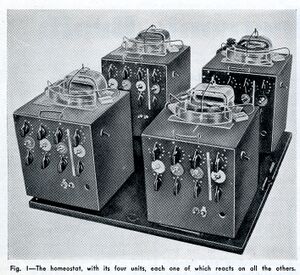
==ROSS ASHBY ON THE HOMEOSTAT==[3]

I will quote Ross Ashby's Design for a Brain at length (1952). I also reproduce the images on those pages (although I have changed the captions to fit this wiki’s format). Here Ashby gives a technical description of the machine which – built by Ashby from parts of old WWII planes and spare components – models a number of things: including an organism, an environment and a brain. This cybernetic organism, by feeding back information from its environment and adapting to any changes made, maintains a “ultrastable” state (“homeostasis”). The most remarkable thing about this machine is that –because it is designed to correct any input which might threaten its stability – it works best when it does very little. At the time, this was difficult for the cyberneticians at the Macy conferences to comprehend. Could the actions it performed be classed as behaviour? Does that behaviour constitute thinking?
Biological organisms (and feedback machines such as the homeostat), are able to alter their patterns of response and bring critical variables back into the desired range. In these cases, energy takes little part in allowing the adaptation of the organism-servo-machine to its environment. Adaptation is afforded through the amount of information running through the system, which allows the organism (or servo machine) to maintain order at the boundary between two loosely coupled systems. In this way learning increases variety (this principle is expressed mathematically in Ashby's Law of Requisite Variety).[4] What puzzled those attending Ashby's presentation of this "organism box" at the 1952 Macy conference [5], was the claim that Ashby made for a broad field of evolutionary development. This led Julian Bigalow to remark: :"It may be a beautiful replica of something, but heaven only knows what." [6]
Whilst some saw the generality of the machine as a shortcoming, others understood it as a breakthrough in understanding a structural equivalence on a number of levels, from the machine, to the individual organism, to the environment. The machine demonstrated how order is maintained on a number of different levels. It was Craik's model par excellence, in that it modelled the structure of the behaviour of a system (be it man made or begotten) without looking anything like the system it modelled.
In what follows we will see how – just as the cybernetic tortoise invites discussions into the nature of self, the intersubjective and the nature of consciousness – the homeostat will invite questions about the dividing line between organism and environment, ecology and media, behaviour and thought. As in previous chapters this cybernetic creature will provide a model for Gregory Bateson to extend his ecology of mind still further, as Ashby’s notions of “requisite variation:” and “flexibility” are applied by Bateson to the realms of biology, ecology and social cohesion.[7]

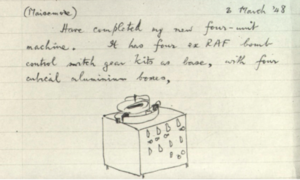
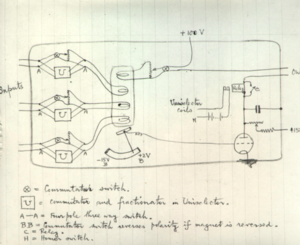
Cite error: Closing </ref> missing for <ref> tag
“Next, the units are joined together so that each sends its output to the other three; and thereby each receives an input from each of the other three. These inputs act on the unit's magnet through the coils A, B, and C, so that the torque on the magnet is approximately proportional to the algebraic sum of the currents in A, B, and C. (D also affects M as a self-feedback.) But before each input current reaches its coil, it passes through a commutator (X),which determines the polarity of entry to the coil, and through a potentiometer (P), which determines what fraction of the input shall reach the coil. As soon as the system is switched on, the magnets are moved by the currents from the other units, but these movements change the currents, which modify the movements, and so on. It may be shown […] that if there is sufficient viscosity in the troughs, the four-variable system of the magnet-positions is approximately state-determined. To this system the commutators and potentiometers act as parameters. When these parameters are given a definite set of values, the magnets show some definite pattern of behaviour; for the parameters determine the field, and thus the lines of behaviour. If the field is stable, the four magnets move to the central position, where they actively resist any attempt to displace them. If displaced, a co-ordinated activity brings them back to the centre. Other parameter-settings may, however, give instability; in which ease a 'runaway' occurs and the magnets diverge from the central positions with increasing velocity-till they hit the ends of the troughs. So far, the system of four variables has been shown to be dynamic, to have Figure 4/15/1 (A) as its diagram of immediate effects, and to be state-determined. Its field depends on the thirty-two parameters X and P. It is not yet ultrastable. But the inputs, instead of being controlled by parameters set by hand, can be sent by the switches S through similar components arranged on a uniselector (or 'stepping-switch') U. The values of the components in U were deliberately randomised by taking the actual numerical values from Fisher and Yates' Table of Random Numbers. Once built on to the uniselectors, the values of these parameters are determined at any moment by the positions of the uniselectors. Twenty-five positions on each of four uniselectors (one to each unit) provide 390,625 combinations of parameter-values. F represents the essential variable of the unit. Its contacts close when and only when the output current exceeds a certain value. When this happens, the coils G of the uniselector can be energised, moving the parameters to new values.”[…] [8]
THE HOMEOSTAT AT MACY
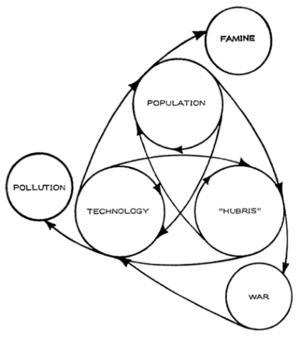
CONSCIOUS PURPOSE–ECOLOGY
In Conscious Purpose versus Nature [9] Gregory Bateson outlines a dialectic that is now familiar to us. Bateson notes that the chain of being and the place of the mind within it – as it had been understood in pre-modern and in non-occidental cultures – has suffered a reversal in the modern Western scientific era. In the modern conception the supreme mind (God/ mind of Man) was at the top, enjoying mastery over the creatures below him, from the higher primates to the protozoa bubbling at the bottom. Bateson argues that this conception does not allow for a conception of mind as imminent within a series of co-extensive systems. The publication of Jean-Baptiste Lamarck's evolutionary theory at the beginning of the 19th century – “the first organised transforms theory of evolution”.[10] ushered in a Copernican revolution in the biological field. Philosophie Zoologique (1809) is revolutionary, Bateson contends, because it acknowledged that the order of nature runs in a converse direction, suggesting that mind is indeed emergent and imminent within an ecology 27.Up until Lamarck "mind was an explanation of the biological world. But, Hey presto, the question now arose: is the biological world the explanation of mind?" […] “Some years [after Lamarck], Russel Wallis, in his correspondence to Charles Darwin described the process of natural selection as akin to the regulation of a steam engine by a governor.”)[11] The full implications of Wallis' insight, that such ecological systems are regulated by negative feedback (an observation also made by Samuel Butler, you may remember), lay dormant until after WWII when the revolution in cybernetics and communication theory allowed for a clearer understanding of feedback as a general regulating principle within different scaled ecological systems (from a single cell to a complex environment, such as Spaceship Earth). It also allowed for an understanding of the formation of social relations and individuation of the human psyche as a process of circular causality driven by purpose. If pre-modern societies had an understanding that mind was coextensive within a series of systems this was rediscovered in the post-cybernetic era as "nowadays cybernetics deals with much more complex systems" of human behaviour, human organization, any biological systems which are all self-corrective. Such systems are always conservative of something, the change in the fuel supply effects the motion of the flywheel which is regulated by the governor. [12]
This transaction, in relation to any system, might be understood as survival. This tendency of self-correcting systems toward conservatism is now directed to the subject of the human psych. Bateson notes that the difficulty people have in seeing the obvious, or with coping with disturbing information is an artefact of the system. The tendency to reinforce resistance to the obvious or the disturbing is systematic. "This is a system which conserves descriptive statements about the human being, body and soul. For the same is true of the psychology of the individual , where learning occurs, to conserve the opinions and components of the status quo." Society and the ecosystem are systems of the same general kind. In all such systems there is an "uneasy balance of dependency and competition". The components of a system are "segmented" so that change is localised [...] The biological system is driven to reproduce, even if, to state the obvious, overpopulation will result in a strain on the larger system: any "monkeying with the system is likely to disrupt the equilibrium."[13]. It is therefore, "quite a trick" to balance dependency and competition. The system is segmented so that no single part has access to the "total mind" . However, and here Bateson introduces a mysterious (almost mystical element), “there is a " "semipermiable" linkage between consciousness and the remainder of the total mind. A certain limited amount of information about what is happening in this larger part of the mind seems to be relayed to what we may call the screen of consciousness."[14] Because the screen of consciousness is a filtration system it necessarily provides partial information. The whole mind cannot be comprehended in part of that mind, to comprehend the circuitry of the system would require more circuitry which produces an infinitely recursive logic &c. The question now arises, how is this limited selection of information which plays on the screen of consciousness selected and filtered? "I am guided in my perception by purposes." , thought is responsive and immanent "I get a myth about this subject which might be quite correct. I am interested in getting that myth as I talk. It is relevant to my purposes that you hear me."[15]. In this anecdote thought is imminent to purpose. Purpose becomes that which builds subjects and relations to subjects within the system.36 Here subjects and objects are performativly produced within a circuit of communication where competition and dependency are central agents.
Here Bateson mounts a critique of instrumental reason and the instrumentalization of cybernetic principles: "What happens to the picture of a cybernetic system [...] when that picture is selectively drawn to answer only questions of purpose?"[16]If a system is organized only in terms of purpose it ends up with a “bag of tricks” and no wisdom about the system as a whole, it is organised to arrive at short cuts and quick fixes and to follow the shortest logical path, which may be "dinner; it may be a Beethoven sonata; it may be sex. Above all it may be money and power." [17]. The cause for concern, for Bateson, is the "addition of modern technology to the old system" The system orientated by purpose that consciousness has been using for more than a million years has produced more effective machinery "transportation systems, airplanes, weaponry, medicine, pesticides, and so forth" all produced through the agency of conscious purpose. [18]
Bateson gives an account of conscious purpose which begins in myth. God, in a retelling of the Judo-Christian creation myth, was cast out of the garden on the day that Adam and Eve worked out how to stack one box on top of another in order to get their hands on the apple. At the point at which they realised that A & B can result in C, and were defined by a local aim and purpose they were "cast out of the garden of the concept of their own systemic nature." our consciousness is conditioned to conscious purpose, which is projected onto the screen of our consciousness, such purpose defines the subjects and objects in our world, we produce technologies to meet those purposes, together these things constitute a system which we strive to preserve. We see as through a glass darkly – "Consciousness is blinded to the systematic nature of the individual man" .
Bateson continues to wax biblical: “Lack of systematic wisdom is always punished”.[19] when presenting the cybernetic paradox of consciousness. Bateson continues to call for a revision of "the occidental errors of epistemology"[20], and calls for a humility in the face of nature and in relation to what is known by human beings. Bateson finds useful models in Zen Buddhism, which challenges the sovereignty of the self in relation to natural systems; artistic or aesthetic pursuits which operate under the order of self-reflexive, deutero-learning which alters the register of hierarchical perception; the 'best of religion' serves as a corrective to 'overrun' (positive feedback producing inflexibility and instability within a system).
In this respect the lines of engagement are ostensibly the same as the 1950s, but the stakes at the end of the 1960s, when an ecological disaster seems imminent, are more desperate. Bateson wrote in Radical Software: “... all of the many current threats to man”s survival are traceable to three root causes: a) technological progress b) population increase c) certain errors in the thinking and attitudes of occidental culture. (Our “values” are wrong!)” [21]
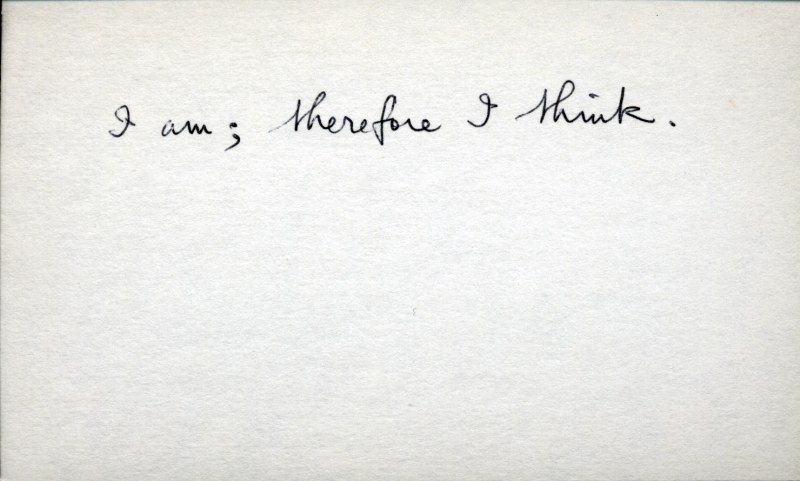 Functionally, the behaviour is the brain.
Functionally, the behaviour is the brain.
- ↑ W. Ross Ashby, Design for a Brain, John Wiley and Sons Publishing, 1952 p.12
- ↑ Ross Ashby, Design for a Brain, John Wiley and Sons Publishing, 1952p. 12
- ↑ Outtakes from previous draft of intro to this chapter. Bateson: "Ross Ashby long ago pointed out that no system (neither computer nor organism) can produce anything new unless the system contains some source of the random. In the computer, this will be a random-number generator which will ensure that the "seeking," trial-and-error moves of the machine will ultimately cover all the possibilities of the set to be explored."| Bateson "I am going to build a church some day. It will have a holy of holies and a holy of holies of holies, and in that ultimate box will be a random numbertable." Stewart Brand recounting an exchange with Bateson's secretary Judy Van Slooten WEC Review p490
- ↑ Peter Harries-Jones, A Recursive Vision: Ecological Understanding and Gregory Bateson p.109
- ↑ "organism box" was coined by Gerard at the 1952 Macy conference. Others in the discussion included McCulloch, Pitts, Bateson, Bigalow and Wiener Cybernetics, The Macy Conferences p 86
- ↑ Cybernetics Macy Conferences p.96
- ↑ Bateson, Restructuring the Ecology of a Great City, Radical Software no 4 1970; & Bateson, Conscious Purpose Versus Nature. StEM 433
- ↑ W. Ross Ashby, Design for a Brain, John Wiley and Sons Publishing, 1952 pp 100-103 |Ashby’s notes on page 100-101 | It was given the name of' Homeostat ' for convenience of reference, and the noun seems to be acceptable. The derivatives homeostatic' and homeostatically', however, are unfortunate, for they suggest reference to the machine, whereas priority demands that they be used only as derivatives of Cannon's ‘homeostasis’. Following the original machine in principle, Mr. Earl .1. KIetsky, at the Technische Hogeschool, Delft, Holland, has designed and built a form that replaces the magnet, coils, vane and water by Kirchhoff adding circuits and capacitors
- ↑ Bateson STEM 433, 1968
- ↑ Bateson, STEM 455
- ↑ STEM 435 Bateson also gives an account of this in Stewart Brand's For God Sake Margaret!, Co-Evolutionary Quarterly 197*
- ↑ StEM 435
- ↑ Bateson, StEM 437
- ↑ Bateson StEM, 438
- ↑ Bateson STEM, 438
- ↑ Bateson STEM,439
- ↑ Bateson STEM,440
- ↑ Bateson StEM,441
- ↑ STEM 441
- ↑ STEM 495
- ↑ Gregory Bateson, Awake, Radical Software No 5 Volume 1, p.33
